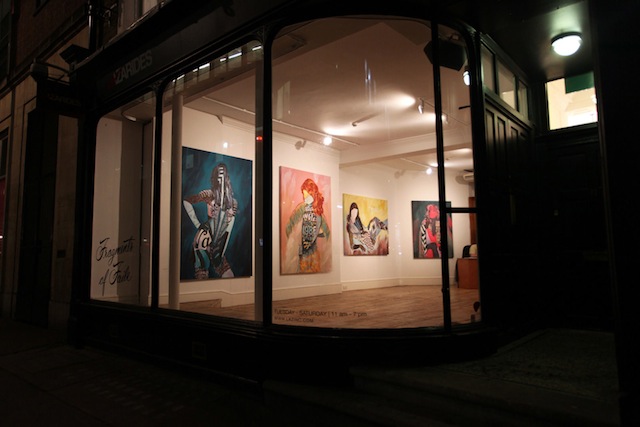
Faile shocked their fans and detractors alike last week when they unveiled their newest body of work at Lazarides’ Gallery’s Rathbone Place location in London. The show, Fragments of Faile, features two distinct series. One is pretty much what you might expect from Faile: Familiar trademark imagery, styles and themes, mixed with some small steps forward. As usual, it was the introduction of new ideas into the Faile repertoire alongside the classics. If you’re a fan of Faile, you’ll like those pieces, and if you’re not, well the new twists probably won’t convince you. Most people I’ve spoken with say these are their favorite pieces in the show, and I have to agree. But those pieces are also getting very little attention compared to the completely new body of work that Faile introduced at the show: 100% painted (no screenprinting) portraits of women made up of abstract fabric patterns and bits of Faile iconography on top of very calm and un-Faile-like backgrounds. While there are a large number of people speaking out and saying how much they enjoy this new twist from Faile, among the people whose views I respect, the majority would not hang these paintings on their walls (although some would). Nuart’s reviews seem to best exemplify the reaction that I’m getting most often from those that I respect. Among that group, the new style has been met with general disappointment and confusion, with some people comparing it to a less gritty Bast or derivative of Miss Bugs (of course, Bast and Faile have collaborated numerous times in the past, and Miss Bugs has in the past been thought of as derivative of Faile). Nonetheless, nearly everyone I’ve heard from has also expressed great excitement that Faile have tried something so unexpected. My thoughts and some perspective from Faile themselves after the jump…
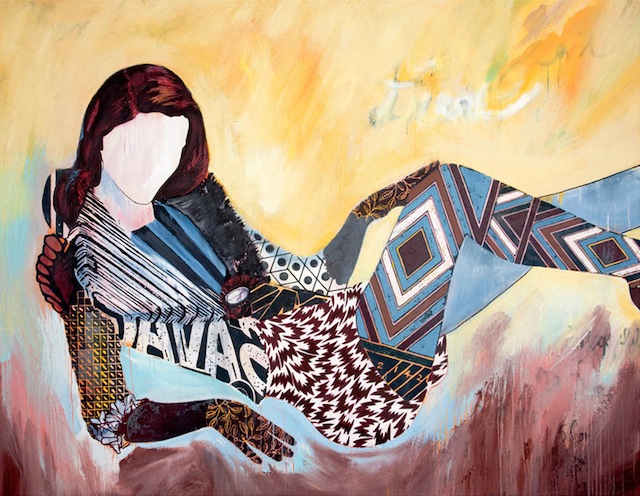
Keep in mind that I have only seen the show online (thanks to their comprehensive micro-site) so, particularly with something so painterly, my lack of a physical experience with this work is a very fair criticism of this post.
My immediate response based on the images Faile posted on their website was to agree with the majority. These works seems a step backwards. I thought of them as simplistic, derivative and just not what I was hoping to see from Faile. Frankly, I could see these paintings hung up in a Levi’s store as in-store displays that ripped off Faile in a mediocre way in order to utilize street culture to sell jeans. That may seem odd since Faile have often referenced advertising in their art, but here it looks like someone made advertising or in-store decoration after looking at Faile’s art, rather than Faile making art after looking at advertising. Most of the new work also seems to lack the energy that makes so much of Faile’s art so jaw-droppingly powerful. Basically, I looked at these pieces and saw something Faile-esque but without that essential energy.
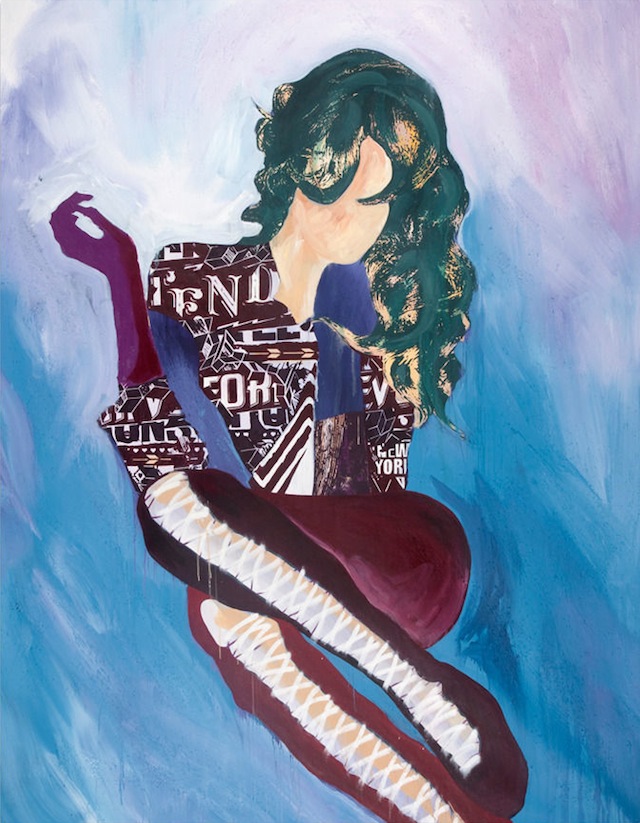
At the same time, I absolutely have to appreciate and respect Faile for trying something so unrecognizably different. Faile tried something new, and, not to sound like my 1st grade soccer coach, that’s what seems most important with this series. For years, Faile’s art has been iconic, but maybe that’s just a fan’s way of saying “the same.” With this new series, they made something that does not, at first glance, appear to be by Faile, but elements that have been appearing in their work in small ways are still very much alive and well and even given center stage, namely fabric patterns and other abstract designs. It would have been easy for Faile to coast along on their previous success and make the kind of art that people expect them to make, but instead they decided to experiment. Taking that risk should be respected, but with risk there’s always the possibility of failure.
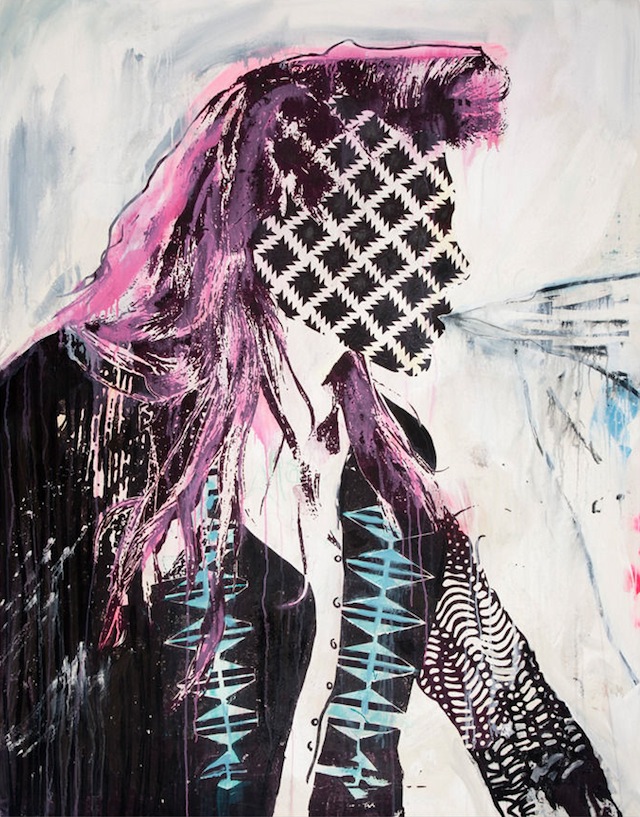
Earlier this week, I had the chance to speak to Faile about this new series as well as the rest of the Fragments of Faile show. The conversation gave me a much better understanding of what Faile were trying to achieve with this new series and more appreciation for the series.
Patrick Miller (one half of the duo) summed up their goals with this series as “What happens if we strip down all the things we normally use to tell stories? Let’s take away the typography. Let’s take away the narratives. Let’s take away the facial expressions. And let’s take away the props and all these things and just try to set out a body of work that is still within the Faile language, but takes away the tools of storytelling that we normally use. And let’s explore painting.” Miller also pointed out that this could be seen as going back to Faile’s roots, since they were putting portraits of women on the street much earlier in their career. Patrick McNeil (the other half of Faile) said “It was almost like turning the work inside out, in a way.”
They also knew full well that the show was going to be controversial, but they noted that if they were going by the public’s immediate reaction to their work, they would never be able to get anything done because there would always be someone to hate on them for either changing or staying the same, so changing things up was a way to make sure that Faile is not pigeonholed or predictable. It came up again and again that they would rather have their fans to experience a WTF moment and think “that was strange and interesting” when going to a Faile show, rather than think something like “Yep. That was cool. It was Faile.”
What I found to be most interesting was a comment McNeil made about where these paintings might fit within the larger body of Faile work. While they did mention wanting to take risks in their studio work and considering their long-term art career (and, in my own opinion, the place they deserve in art history), McNeil described the series as a learning process where they learned about their own processes of image-making and painting with lessons and ideas that could be brought into a more classic Faile artwork. For me, that’s where the real value in these paintings can be found. The images aren’t something that I’m drawn to for whatever reason, so I’m not sure that seeing the work in the flesh would change that, but I can imagine how the experiments that resulted in this series could be brought back until the traditional Faile umbrella with results that would get me excited. It’s fantastic to see that Faile are open to such experimentation and haven’t become stuck in a rut where they do nothing but repeat the same things over and over ad infinitum. If they make some work along that way that I or many of their fans don’t dig, that’s life and I think there’s still something positive that will inevitably result from this series. In fact, to a small degree, it already has.
In addition to the painted works, Faile made single-layer screenprints of the same basic image, almost like a sketch for the final product. I much prefer these small prints to any of the paintings in this series. Here are a couple of examples:
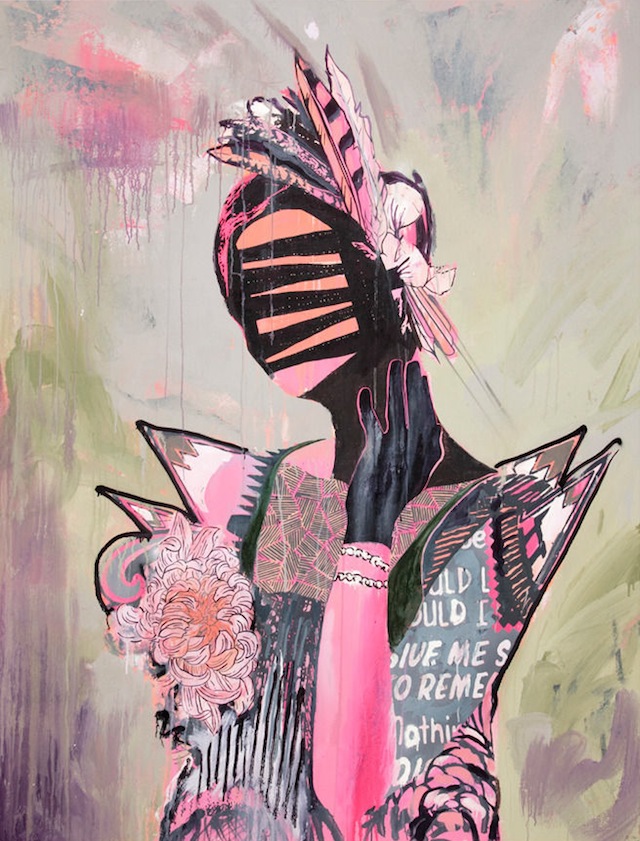
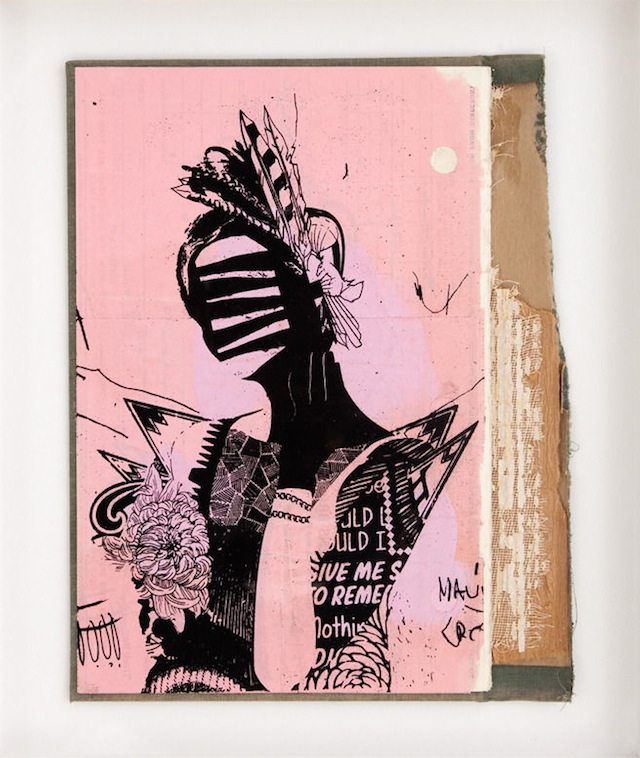
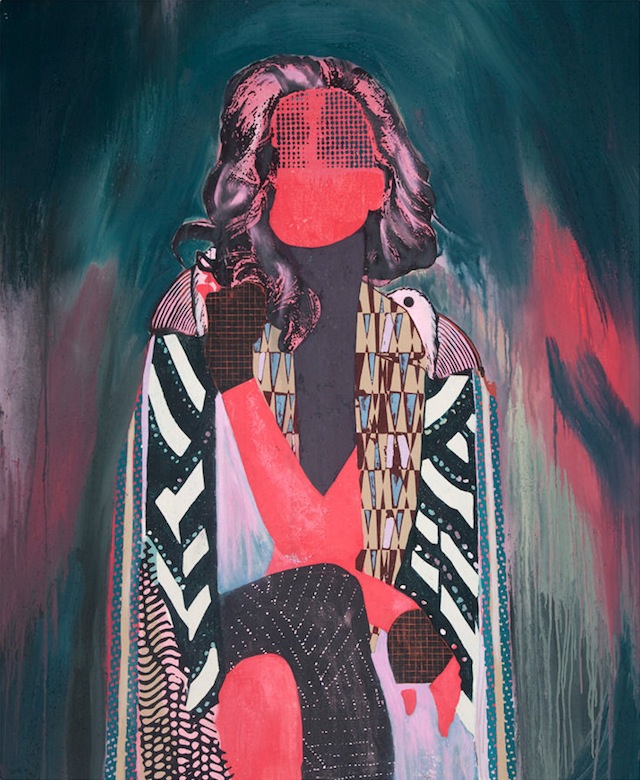
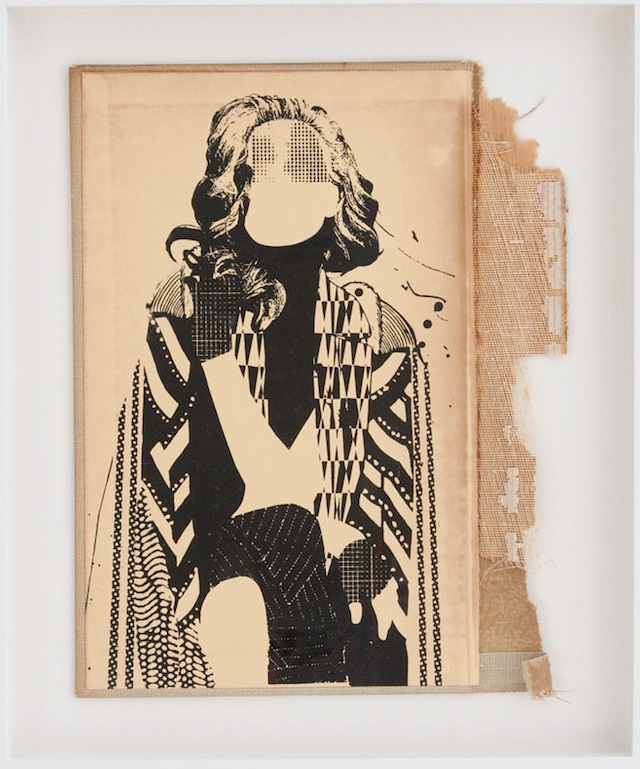
Also, working off of the abstractions that they experiment with in these paintings, Faile went further than I’ve ever seen them go before with bringing abstraction into their screenprints, and I’m loving it:
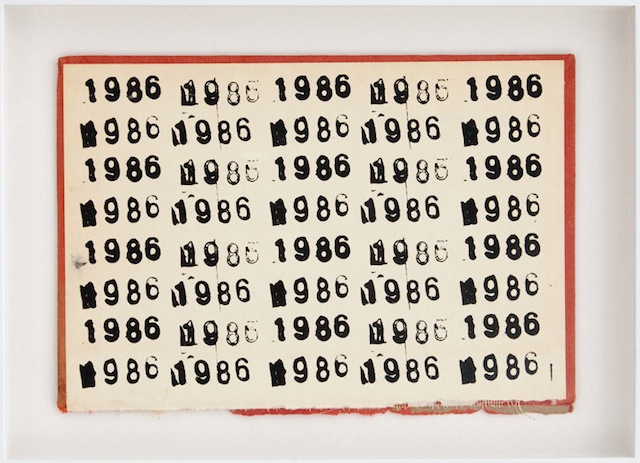
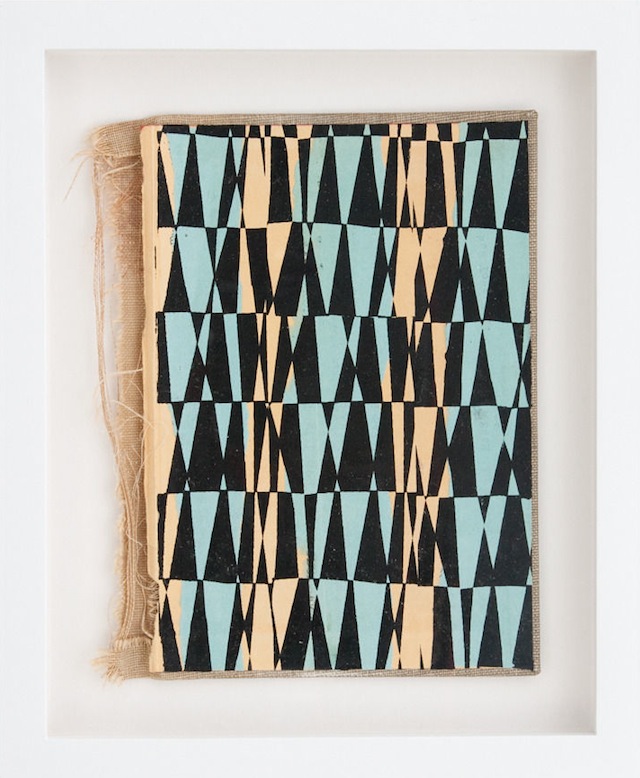
Fragments of Faile also included new work on wood, which is more like what Faile have been making for the last few years, but with the new addition of t-shirts, some of the imagery from the paintings on canvas, copper plates and more dimensionality:

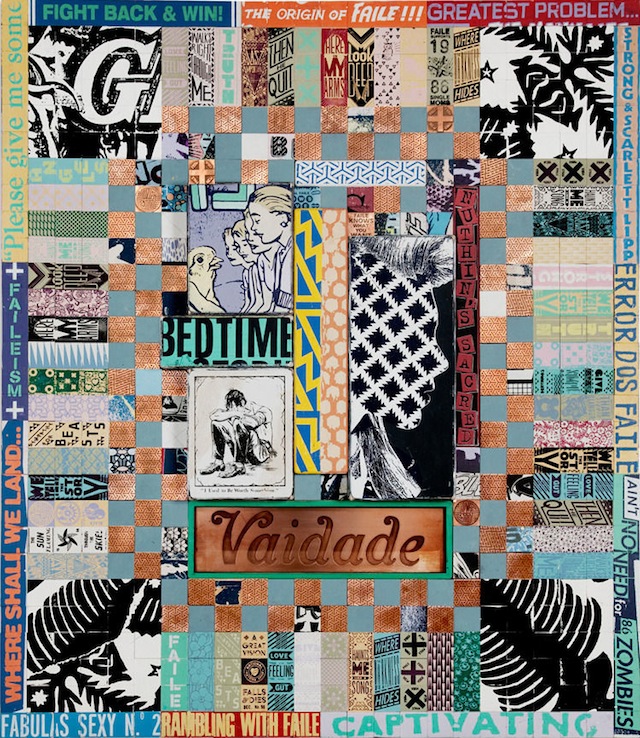
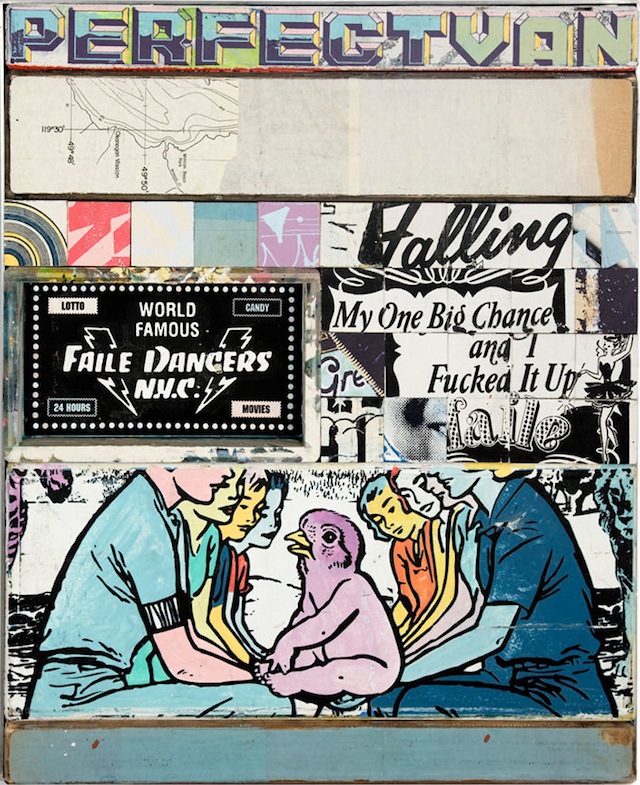
Fragments of Faile is open at Lazarides Gallery‘s Rathbone Place location in London now through December 3rd.
Photos by Faile
